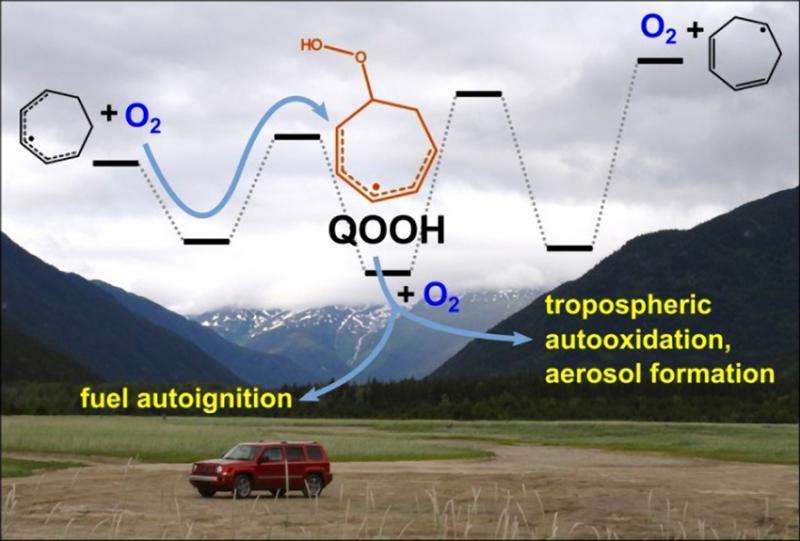Combustion's mysterious "QOOH" radicals exposed

Researchers can now discriminate between the previously unidentified hydroperoxyalkyl radicals found in the early stages of the combustion process from similar compounds, thanks to data from the Advanced Light Source at Lawrence Berkeley National Laboratory. In addition, researchers can directly measure QOOH reactivity. The characterization and measurement experiments were confirmed by detailed calculations of the reaction mechanism.
These combined experimental and theoretical results serve as a critical benchmark for further calculations and model predictions of the entire family of ignition chemistry reactions. More accurate models will speed production of increasingly efficient combustion engines and provide a scientific foundation that informs policy decisions regarding impacts a changing climate may have on our national security.
The net combustion reaction on paper is very straightforward: oxygen reacts with hydrocarbons to form water and carbon dioxide. However, the intricate details of how all the bonds break and form during the reaction are extremely complicated. Researchers have now directly detected a critical long-postulated-but-elusive piece of the combustion puzzle – hydroperoxyalkyl radicals, also called QOOH intermediates. This intermediate results from bound oxygen stripping a hydrogen atom from carbon, oxidizing the organic compound, and leaving a carbon-centered radical behind.
These species and their interactions with oxygen are responsible for the radical chain reactions that sustain autoignition, or the early stages of the combustion process, in vehicles. Further, these species are implicated in atmospheric oxidation processes that can form low-volatility compounds that typically condense to form aerosol particles. The researchers directly observed and measured the kinetics of a QOOH intermediate in the oxidation of 1,3-cycloheptadiene, a molecule that offers insight into both resonance-stabilized (delocalized electrons) and nonstabilized radical intermediates.
The results establish that resonance stabilization dramatically changes QOOH reactivity and, hence, that oxidation of unsaturated organic compounds (hydrocarbon compounds with double and/or triple carbon-carbon bonds) can produce exceptionally long-lived QOOH intermediates. Developing this knowledge of QOOH intermediates is crucial for many future developments, ranging from improved climate models to "clean" combustion engines.
More information: "Direct observation and kinetics of a hydroperoxyalkyl radical (QOOH)." Science 347, 643 (2015).
"Directly measuring reaction kinetics of QOOH – a crucial but elusive intermediate in hydrocarbon autoignition." �鶹��Ժical Chemistry Chemical �鶹��Ժics 15, 10753 (2013).
Kinetics of elementary reactions in low-temperature autoignition chemistry." Progress in Energy and Combustion Science 37, 371(2011).
"Formally direct pathways and low-temperature chain branching in hydrocarbon autoignition: the cyclohexyl + O2 reaction at high pressure." �鶹��Ժical Chemistry Chemical �鶹��Ժics 11, 1320 (2009).
"Infrared frequency-modulation probing of product formation in alkyl + O2 reactions. Part IV. Reactions of propyl and butyl radicals with O2," Faraday Discussions 119, 101 (2002).
Journal information: Science , �鶹��Ժical Chemistry Chemical �鶹��Ժics
Provided by US Department of Energy



















